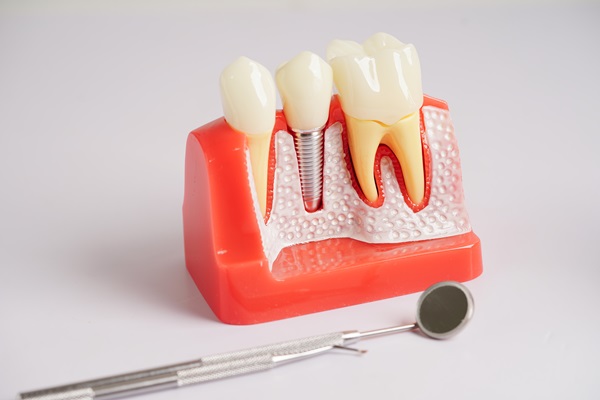When a Dental Crown May Need to Be Replaced

If you've suffered a broken or damaged tooth, you may want to consider a dental crown to restore your damaged smile. It's important, however, to know when your crown is getting worn and when it is time to get it replaced so that you can keep your smile looking its best. Proper maintenance and care are key to keeping your smile functioning properly.
A dental crown is a cover that fits over the tooth to protect it. Dental crowns are often necessary when teeth have been broken, decayed, or worn down. The dentist will take an impression of your mouth and create a mold for the new crown. This article discusses signs indicating when you may need to receive another crown to maintain optimal oral health.
Tooth sensitivity
If your tooth feels sensitive to hot and cold food, you may need more time for the crown to bond with your tooth. You can also try using fluoride varnish or fluoride gel on the teeth so they will be protected from acids in foods that cause sensitivity.
Once your dentist replaces a crowned tooth, they will likely check for cavities underneath it and monitor the area surrounding where the old crown was placed to prevent future problems. If, for some reason, the tooth is decaying underneath the crown or you have an underlying issue like an infection, then the dentist may need to remove the crown to treat the infected area before replacing the crown.
Drifting or moving
If the crown is moved out of its original position after being fitted by your dentist, other methods are available to ensure that your teeth are still protected. The tooth may be stabilized with a crown or other means, but you should check in with the dentist right away.
If you notice moving, report it to your dentist right away. Shifting and movement affect the look and position of your crown but depending on the position of your other teeth and how much space you have, it can cause significant damage to your other teeth as it shifts them out of position.
Cracks and chips
Chips and cracks on the crown surface are the most common reasons people visit their dentist. Generally, if there is a large enough crack or chip that could fall out, you should receive new dental work to replace your old one. A bad enough chip or crack exposes the damaged tooth underneath and causes more harm to your tooth if you go for long without having it replaced.
Once your dentist has fitted the crown, they will ensure that it does not chip or crack. If it does, there are other types of restorations available to you. You can also talk to your dentist about ways to care for your crown and potential behavior that can lead to additional wear and tear. This way, you can void additional dental visits and have to have your crown replaced more frequently.
Discoloration or spots on the crown
If the crown is starting to show signs of discoloration or spots, it can indicate problems with cavities underneath. If this occurs, your dentist will take an x-ray to check for cavities and make sure that you receive new dental work if necessary.
Dental crowns can sometimes discolor over time. This is because saliva and other elements can seep through them, causing stains that make your tooth look less beautiful. Please talk with your dentist about how they would like to handle this issue.
Gum pain or bleeding
If you are experiencing gum pain or bleeding, there is a good chance that the crowns need to be replaced. Your dentist will take an x-ray of your tooth to check for cavities underneath it and make sure that you receive new dental work if necessary.
The crown's gum tissue may become irritated if it does not fit properly. This can cause pain or swelling in your gums when brushing, flossing, or biting down on food. Talk with your dentist about how to make sure that this problem does not continue to occur.
A change in the bite as you chew food
The last thing you want to do is replace your crowns because they are not working. Make sure that the bite feels normal when chewing food before deciding if it needs replacing or other measures need to be taken by your dentist.
Speak with your dentist
If your smile is less than perfect, reach out to your dentist to learn about the options available to you. They can walk you through the services that are available, and together you can make the right choice for your teeth. It's important to address these issues as soon as possible to avoid further complications.
Request an appointment here: https://www.allsmilesdentalcenter.com or call All Smiles Dental Center at (210) 714-7429 for an appointment in our San Antonio office.
Check out what others are saying about our dental services on Yelp: Dental Crowns in San Antonio, TX.
Recent Posts
A dental crown can fix a broken tooth. An accident, biting on a piece of hard food, or an intense hit to your face can cause this dental injury. You then experience pain and sensitivity, not to mention self-consciousness about the unsightly appearance of your broken tooth. It is a good thing that modern dentistry…
Many times, dental crowns are used to repair weakened or damaged teeth, especially those impacted by severe decay. However, this type of treatment also has a place in cosmetic dentistry. It can often be used to improve the overall look of a patient's smile.While at first glance they can seem like little more than a…
A cosmetic dentist can use a dental dental crowns to improve your dental health. A tooth with severe decay or discoloration can be depressing. The infection could reach the pulp at any time. Placing a custom-fit dental crown can protect your tooth from further damage and injury. If you want to know more about the…
For patients in need of dental crowns, there are plenty of options available. Two of the most common choices are porcelain crowns and metal crowns (often with a porcelain overlay fused to the metal). Depending on a patient's specific circumstances, one of these crown types may be the preferred option.Metal crowns have the advantage of…


